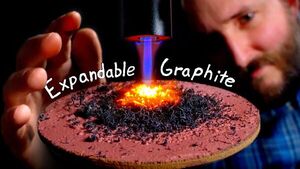2023-02-16 - Nº 407
Editorial
Esta é a Newsletter Nº 407 que se apresenta com o mesmo formato que as anteriores. Se gostar da Newsletter partilhe-a!
Todas as Newsletters encontram-se indexadas no link.
Esta Newsletter tem os seguintes tópicos:
Faz hoje anos que nascia, em 1514, o astrónomo e matemático alemão Georg Joachim Rheticus. Ele foi um dos primeiros a adoptar e difundir a teoria heliocêntrica de Nicolau Copérnico. Foi primeiro ensinado pelo seu pai, um médico, que foi decapitado por feitiçaria (1528) enquanto Rheticus ainda era adolescente. Ele é mais conhecido como o primeiro discípulo de Copérnico. Em 1540, Rheticus publicou o primeiro relato da hipótese heliocêntrica que tinha sido elaborada por Copérnico, intitulado Narratio prima, que foi explicitamente autorizado por Copérnico, que também pediu a ajuda do seu amigo para editar a edição do seu De revolutionibus orbium coelestium ("Sobre as revoluções das esferas celestiais"). Rheticus foi o primeiro matemático a considerar as funções trigonométricas em termos de ângulos e não de arcos de um círculo.
Faz também hoje anos que nascia, em 1698, o físico francês Pierre Bouguer. Ele fundou a fotometria, a medição da intensidade da luz. Era uma criança prodígio, professor aos 15 anos, seguindo o seu pai, Jean Bouguer, em hidrografia - o estudo dos corpos de água, tanto salgada como fresca. Participou na expedição ao Peru (1735-44) para medir um arco do meridiano perto do equador. Em 1729, inventou um fotómetro para comparar a intensidade de duas fontes de luz iluminando metades separadas de papel translúcido. O próprio olho, ele determinou, não podia ser utilizado como um metro, mas podia estabelecer a igualdade de brilho das superfícies adjacentes. Ele determinou que o sol era 300 vezes mais brilhante do que a lua. A lei de Bouguer dá a atenuação de um feixe de luz por um meio opticamente homogéneo (transparente).
Faz igualmente hoje anos que nascia, em 1826, o químico dinamarquês Julius Thomsen. Ele tabulou a quantidade de calor libertada ou absorvida em 3.500 reacções químicas. Ele originou o termo acidez e preparou a primeira tabela das forças relativas dos ácidos. Tornou-se rico com o seu processo (patenteado em 1853) para a fabricação de soda a partir da criolita mineral. Em 1878, Thomsen (e independentemente por Marcellin Berthelot) propôs que cada mudança química prosseguisse numa direcção tal que produzisse o maior calor. No entanto, esta afirmação é incorrecta, pois são conhecidas muitas excepções em que as reacções químicas são espontâneas, apesar de absorverem calor. Thomsen concebeu o formato moderno de grupos e períodos na forma longa da Tabela Periódica dos Elementos (1895).
Faz também hoje anos que nascia, em 1843, o inventor e industrial americano Henry Martyn Leland. Ele fundou a Cadillac Motors (22 de Agosto de 1902) para construir o Cadillac, o primeiro automóvel com peças de alta precisão e totalmente intercambiáveis. No início da sua vida, tinha aprendido a fabricar espingardas de precisão durante a Guerra Civil, inventou os primeiros cortadores mecânicos de barbeiro, e fez motores para Oldsmobiles. Quando Leland concebeu um motor melhorado, mas Olds não o quis adoptar, Leland iniciou a Cadillac para construir a sua própria marca de automóveis. Ele acabou por vender a empresa à Will Durant's General Motors Co. Durante a I Guerra Mundial, formou uma nova empresa para fabricar motores de aviões, que após a guerra produziu um novo automóvel: o Lincoln. Esta empresa foi comprada por Henry Ford.
Faz igualmente hoje anos que nascia, em 1901, o químico e inventor inglês John Rex Whinfield. Ele (assistido por James Tennant Dickson) inventou um novo poliéster, tereftalato de polietileno, (1941) a partir da reacção de condensação de etilenoglicol com ácido tereftálico. Eram químicos empregados pela Calico Printer's Association of Manchester. A patente que registaram em Julho de 1941 foi adiada pela II Guerra Mundial, mas acabou por ser registada em 1946. Como fibra têxtil, foi-lhe atribuído o nome comercial Terylene quando foi comercializada na Grã-Bretanha (1947) pela Imperial Chemical Industries (ICI), que comprou os direitos, e para quem Whinfield trabalhou a partir de 1947. Quando os direitos norte-americanos foram comprados e desenvolvidos pela Dupont na América, era conhecida como Dacron. O material continua a ser popular para lavar e usar roupa.
Por fim, faz hoje anos que nascia, em 1935, o engenheiro e inventor norte-americano Bradford Parkinson. Ele é conhecido como o arquitecto líder, defensor e promotor, com as primeiras contribuições de Ivan Getting e Roger Easton, do programa NAVSTAR da Força Aérea, mais conhecido como Sistema de Posicionamento Global.
Na Newsletter desta semana apresentamos diversas noticias, artigos científicos, projetos de maker e alguns vídeos interessantes.
 João Alves ([email protected])
João Alves ([email protected])
O conteúdo da Newsletter encontra-se sob a licença  Creative Commons Attribution-NonCommercial-ShareAlike 4.0 International License.
Creative Commons Attribution-NonCommercial-ShareAlike 4.0 International License.
Novidades da Semana
Outras Notícias

NASA’s Webb Reveals Intricate Networks of Gas, Dust in Nearby Galaxies
"Peering through obscuring clouds of dust, the MIRI instrument has revealed networks of giant cavities and blown-out bubbles in the gaseous arms of distant galaxies. Researchers using NASA’s James Webb Space Telescope are getting their first look at star formation, gas, and dust in nearby galaxies with unprecedented resolution at infrared wavelengths. The data has enabled an initial collection of 21 research papers which provide new insight into how some of the smallest-scale processes in our universe – the beginnings of star formation – impact the evolution of the largest objects in our cosmos: galaxies. The largest survey of nearby galaxies in Webb’s first year of science operations is being carried out by the Physics at High Angular resolution in Nearby Galaxies (PHANGS) collaboration, involving more than 100 researchers from around the globe. The Webb observations are led by Janice Lee, Gemini Observatory chief scientist at the National Science Foundation’s NOIRLab and affiliate astronomer at the University of Arizona in Tucson. The team is studying a diverse sample of 19 spiral galaxies, and in Webb’s first few months of science operations, observations of five of those targets – M74, NGC 7496, IC 5332, NGC 1365, and NGC 1433 – have taken place." [...]
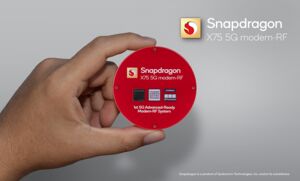
Qualcomm Sparks the Next Phase of 5G With the World’s First 5G Advanced-Ready Modem-RF System
"Qualcomm Technologies’ 6th generation modem-to-antenna solution is the first ready to support 5G Advanced, the next phase of 5G. It introduces a new architecture, a new software suite and includes numerous world’s first features to push the boundaries of connectivity including coverage, latency, power efficiency and mobility. Snapdragon X75 technologies and innovations empower OEMs to create next generation experiences across segments including smartphones, mobile broadband, automotive, compute, industrial IoT, fixed wireless access and 5G private networks. Snapdragon X75 is the first Modem-RF System with a dedicated hardware tensor accelerator, Qualcomm® 5G AI Processor Gen 2, enabling over 2.5 times better AI performance compared to Gen 1 and introduces Qualcomm® 5G AI Suite Gen 2 with new AI-powered optimizations to achieve better speeds, coverage, mobility, link robustness and location accuracy. The Qualcomm 5G AI Suite features advanced AI-based capabilities including world’s first sensor-assisted mmWave beam management and AI-enhanced GNSS Location Gen 2, which uniquely optimize Snapdragon X75 for superior 5G performance. Powered by a new modem-to-antenna upgradeable architecture, Snapdragon X75 is purpose-built for scalability and enables unmatched 5G performance with key features such as: - World’s first 10-carrier aggregation for mmWave, 5x downlink carrier aggregation and FDD uplink MIMO for sub-6 GHz bands, which allow for unparalleled spectrum aggregation and capacity." [...]

Intel Launches New Xeon Workstation Processors – the Ultimate Solution for Professionals
"Intel today announced the new Intel® Xeon® W-3400 and Intel® Xeon® W-2400 desktop workstation processors (code-named Sapphire Rapids), led by the Intel® Xeon® w9-3495X, Intel’s most powerful desktop workstation processor ever designed. Built for professional creators, these new Xeon processors provide massive performance for media and entertainment, engineering and data science professionals. With a breakthrough new compute architecture, faster cores and new embedded multi-die interconnect bridge (EMIB) packaging, the Xeon W-3400 and Xeon W-2400 series of processors enable unprecedented scalability for increased performance. Xeon W-3400 and Xeon W-2400 processors provide the high-end computing foundation that today’s professionals require for the future of computing. Support for DDR5 RDIMM memory, PCIe Gen 5.0 and Wi-Fi 6E gives professionals the cutting-edge platform technologies they require for the compute workloads of the future. Additionally, support for Intel vPro® enterprise technology, alongside ECC memory and reliability, availability and serviceability (RAS) technologies, ensures workstation uptime is maximized so professionals don’t have to worry about workflow interruptions. Available with up to 56 cores in a single socket, the top-end Intel Xeon w9-3495X processor features a redesigned memory controller and larger L3 cache, delivering up to 28% single-thread1 and up to 120% multithread performance improvements2 over the previous generation." [...]

STMicroelectronics introduces highly integrated 32-channel ultrasound transmitter optimized for handheld scanners
"STMicroelectronics has expanded its family of advanced ultrasound transmitters by adding a 32-channel variant with high output current for portable applications. The new transmitter, STHVUP32, provides ±800mA aimed at portable systems that demand extra drive capability for a coaxial cable-mounted probe. Joining the portfolio alongside the 64-channel STHVUP64, the new 32-channel version contains similar features to increase performance and integration in next-generation affordable, high-performing scanners for medical and industrial applications. These include innovations to maximize image quality, built-in digital beam steering, a space-saving driver architecture, and low power consumption. The STHVUP32 has 5-level output capability, in addition to the common 3-level output, which enhances flexibility to optimize the picture quality. Its high output current allows driving the scanner’s piezoelectric transducer at high speed to enable multiple imaging modes." [...]
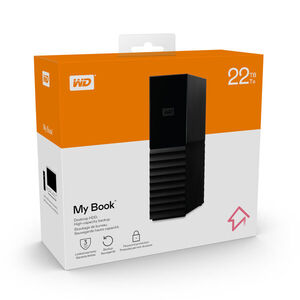
Western Digital Brings Milestone Capacity to Everyday Consumers as Data Creation Continues to Soar
"To help consumers preserve their ever-growing digital world, Western Digital's WD® brand is expanding its trusted My Book™ Desktop Storage lineup. Built upon a legacy of technology innovation, the company has released its highest capacity consumer drive ever with the 22TB* My Book™ Desktop Hard Drive, giving people greater flexibility to store more of what they love. "Consumers continue generating data at a rapid pace. In 2022 alone, the average household worldwide generated more than 20TB of data1 and we expect this number to continue to rise as people continue to consume and create more data," said John Rydning, research vice president, Global DataSphere at International Data Corporation (IDC), a global market intelligence firm. "While many people rely on the cloud, we know consumers are looking for local storage at their fingertips to help them preserve and readily control their growing amount of personal and business data." With more than ten connected devices in the average American household2, the new high-capacity solutions give people a significant amount of space to essentially help backup their personal devices— and possibly even those of their household's as well." [...]

NASA’s Perseverance Rover Shows Off Collection of Mars Samples
"The Red Planet rover snapped a portrait of the sample depot it has assembled with 10 backup sample tubes that could be returned to Earth by a future mission. Even space robots know what “pics or it didn’t happen” means: NASA’s Perseverance Mars rover provided a panorama of its recently completed sample depot – a big milestone for the mission and humanity’s first collection of samples on another planet. The panorama, stitched together from 368 images that were sent to Earth, captures more than a month of careful placement and mapping of 10 titanium tubes. Eight of those tubes are filled with rock and regolith (broken rock and dust), while one is an atmospheric sample and one is a “witness” tube. The rover photographed the depot using the Mastcam-Z camera on the top of its mast, or “head,” on Jan. 31, 2023. The color has been adjusted to show the Martian surface approximately as it would look to the human eye." [...]

STMicroelectronics reveals broad selection of antenna-matching RF integrated passive devices for STM32WL MCUs
"STMicroelectronics has released nine RF integrated passive devices (RF IPDs) that combine antenna impedance-matching, balun, and harmonic-filter circuity optimized for STM32WL wireless microcontrollers (MCUs). ST’s STM32WL MCUs combine application-level processing and wireless communication for smart, connected devices, by integrating an Arm® Cortex®-M4 MCU with a sub-GHz long-range radio managed by a Cortex-M0+ core. The radio is LPWAN compliant, supports multiple modulation schemes, and comes with LoRaWAN® and Sigfox™ stacks included in the STM32CubeWL MCU software package. The RF IPDs, packaged as tiny chip-scale devices, connect the STM32WL MCU to its antenna and help maximize the RF performance. By integrating all the components on one die, they ensure consistent performance avoiding the process variations that affect conventional matching networks built with discrete components. They also simplify circuit design, save on bill of materials, and permit a smaller form factor, making them ideal for cost-sensitive and space-constrained IoT devices." [...]

MediaTek Launches Dimensity 7200 to Amplify Gaming and Photography Smartphone Experiences
"4nm chipset introduces new Dimensity 7000 series expanding MediaTek’s range of high-tech offerings. MediaTek MediaTek today announced the Dimensity 7200, its inaugural chipset in the new Dimensity 7000 series. The Dimensity 7200 boasts cutting-edge AI imaging features, powerful gaming optimizations, and impressive 5G speeds, all with deeply engrained power savings for extended battery life. The Dimensity 7200 delivers the same TSMC 4nm second-generation process found in the Dimensity 9200, and is ideal for ultra-slim designs in a variety of form factors. The octa-core CPU integrates two Arm Cortex-A715 cores, featuring operating speeds of up to 2.8GHz, with six Cortex-A510 cores, so users can effortlessly multitask and take advantage of peak performance in every app. To further optimize power and performance, MediaTek’s built-in AI Processing Unit (APU) maximizes the efficiency of AI tasks and AI-fusion processing." [...]

Samsung Introduces Easily Regenerable Air Purification Filter Technology Applying Photocatalysts
"Newly developed filter simultaneously removes particulate matter and volatile organic chemicals as primary air pollutants while retaining initial performance for up to 20 years Samsung Electronics today introduced a new air filter technology that simultaneously collects particulate matter (PM) and decomposes Volatile Organic Compounds (VOCs) and can be used for 20 years through simple water washing. A study about the technology was published in the journal Nature Communications on 15th February UK Time. “This project started from listening to suggestions from manufacturers and users of air purification filters,” said Hyuk Jae Kwon, one of the lead-/corresponding authors at Samsung Advanced Institute of Technology (SAIT). “We plan to expand the research into accelerating the commercialization of long-lifetime filters in the future.” Conventional air purification filters need frequent replacement because of their short cycle of six months to one year. In addition, every single filter can only remove either PM or VOCs, respectively, limiting air purifiers’ space efficiency. To address these problems, researchers at SAIT developed and implemented an unprecedented filter technology that applies photocatalysts such as copper oxide (Cu2O) and titanium dioxide (TiO2) for the first time and verifies the viability for commercialization." [...]

VISTA X-62 Advancing Autonomy And Changing The Face Of Air Power
"The Lockheed Martin (NYSE: LMT) VISTA X-62A, a one-of-a-kind training aircraft, was flown by an artificial intelligence agent for more than 17 hours recently, representing the first time AI engaged on a tactical aircraft. VISTA, short for Variable In-flight Simulation Test Aircraft, is changing the face of air power at the U.S. Air Force Test Pilot School (USAF TPS) at Edwards Air Force Base in California. VISTA is a one-of-a-kind training airplane developed by Lockheed Martin Skunk Works® in collaboration with Calspan Corporation for the USAF TPS. Built on open systems architecture, VISTA is fitted with software that allows it to mimic the performance characteristics of other aircraft. "VISTA will allow us to parallelize the development and test of cutting-edge artificial intelligence techniques with new uncrewed vehicle designs," said Dr. M. Christopher Cotting, U.S. Air Force Test Pilot School director of research. "This approach, combined with focused testing on new vehicle systems as they are produced, will rapidly mature autonomy for uncrewed platforms and allow us to deliver tactically relevant capability to our warfighter."" [...]
Ciência e Tecnologia

Four classes of planetary systems
"A team from UNIGE and UNIBE reveals that the distribution of planets can be organised in four different ways around a star. Astronomers have long been aware that planetary systems are not necessarily structured like our solar system. Researchers from the Universities of Bern and Geneva, as well as from the National Centre of Competence in Research PlanetS, have now shown for the first time that there are in fact four types of planetary systems. This classification will allow scientists to study planetary systems as a whole and to compare them with other systems. The results can be found in the journal Astronomy and Astrophysics. In our solar system, everything seems to be in order: The smaller rocky planets, such as Venus, Earth or Mars, orbit relatively close to our star." [...]
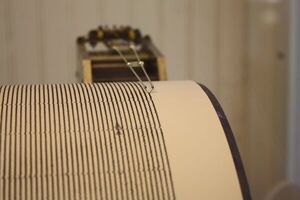
Earthquake Scientists Have a New Tool in the Race to Find the Next Big One
"An everyday quirk of physics could be an important missing piece in scientists’ efforts to predict the world’s most powerful earthquakes. In a study published in the journal Science, researchers at The University of Texas at Austin discovered that a frictional phenomenon could be key to understanding when and how violently faults move. That’s because the phenomenon, which explains why it takes more effort to shove a heavy box from a standstill than it does to keep it moving, governs how quickly the fault surfaces bond together, or heal, after an earthquake. A fault that is slow to heal is more likely to move harmlessly, while one that heals quickly is more likely to stick until it breaks in a large, damaging earthquake. The discovery could be key to understanding when, and how violently, faults move. That alone won’t allow scientists to predict when the next big one will strike — the forces behind large earthquakes are too complex — but it does give researchers a valuable new way to investigate the causes and potential for a large, damaging earthquake to happen, the authors said." [...]
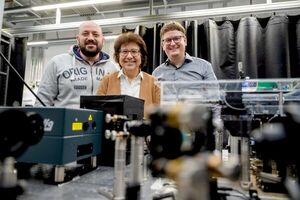
Tsunami in a water glass
"A new experiment has made it possible to observe the effects of an electron in solution on the surrounding liquid. So-called hydrated electrons play a major role in many physical, chemical and biological processes. They are not bound to an atom or molecule and are free in the solution. Since they are only ever created as an intermediate product, they are extremely short-lived. The team from the Cluster of Excellence Ruhr Explores Solvation RESOLV at Ruhr University Bochum was able to observe for the first time in a novel experiment how the hydrated electron affects the solution during its lifetime. The researchers led by Professor Martina Havenith-Newen report in the journal Proceedings of the National Academy of Science PNAS of 15 February 2023." [...]
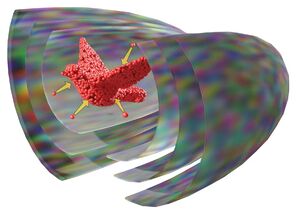
Creating 3D objects with sound
"Scientists assemble matter in 3D using sound waves for 3D printing Scientists from the Max Planck Institute for Medical Research and the Heidelberg University have created a new technology to assemble matter in 3D. Their concept uses multiple acoustic holograms to generate pressure fields with which solid particles, gel beads and even biological cells can be printed. These results pave the way for novel 3D cell culture techniques with applications in biomedical engineering. Additive manufacturing or 3D printing enables the fabrication of complex parts from functional or biological materials. Conventional 3D printing can be a slow process, where objects are constructed one line or one layer at a time. Researchers in Heidelberg and Tübingen now demonstrate how to form a 3D object from smaller building blocks in just a single step." [...]

Princeton in space: NASA’s IMAP mission clears critical hurdle to launch
"NASA’s Interstellar Mapping and Acceleration Probe (IMAP) mission, led by Princeton’s David McComas, recently crossed a vital threshold. On Jan. 27, NASA officials reviewed all aspects of the mission design and approved the mission to continue toward launch, currently scheduled for 2025. This was the culmination of a string of individual “critical design reviews” conducted for all the instruments and subsystems. While there are still challenges ahead to face as a team, the review board chair noted that IMAP was “good to go.” McComas, a professor of astrophysical sciences and the principal investigator for the IMAP mission, expressed his gratitude to the board for good questions and admitted a low-sleep week as the team pondered improving solutions and responses to those issues. “New challenges will surely emerge between now and launch, but I have every confidence in the awesome, committed and resilient team that we have assembled to carry out this challenging mission,” he told the team. “We’re finally starting to see the integration of all these efforts, which is absolutely remarkable for me to see,” said deputy principal investigator Nathan Schwadron, the Norman S. and Anna Marie Waite Professor of Physics at the University of New Hampshire and a visiting research collaborator at Princeton." [...]

How a Record-Breaking Copper Catalyst Converts CO2 Into Liquid Fuels
"Researchers at Berkeley Lab have made real-time movies of copper nanoparticles as they evolve to convert carbon dioxide and water into renewable fuels and chemicals. Their new insights could help advance the next generation of solar fuels. Since the 1970s, scientists have known that copper has a special ability to transform carbon dioxide into valuable chemicals and fuels. But for many years, scientists have struggled to understand how this common metal works as an electrocatalyst, a mechanism that uses energy from electrons to chemically transform molecules into different products. Now, a research team led by Lawrence Berkeley National Laboratory (Berkeley Lab) has gained new insight by capturing real-time movies of copper nanoparticles (copper particles engineered at the scale of a billionth of a meter) as they convert CO2 and water into renewable fuels and chemicals: ethylene, ethanol, and propanol, among others. The work was reported in the journal Nature last week." [...]

Sensing water for smarter agriculture
"MOF-based soil moisture monitoring device a step toward precision irrigation. Smart electronic soil sensors could enable farmers to deliver tailored doses of water to their crops, maximizing food production while saving water. KAUST researchers have developed a rapid and sensitive soil moisture sensor, at the heart of which sits a metal-organic framework (MOF) with a very high affinity for water. Efficient water usage is a key challenge for farmers faced with feeding the growing global population in the face of climate change. “Irrigation management can help improve crop quality, decrease agricultural costs and preserve water,” says Mohamed Eddaoudi, who led the research along with Khaled Salama. “Highly sensitive and selective soil-moisture sensors offer the potential to improve the water management process,” Salama adds." [...]

How to pull carbon dioxide out of seawater
"A new method for removing the greenhouse gas from the ocean could be far more efficient than existing systems for removing it from the air. As carbon dioxide continues to build up in the Earth’s atmosphere, research teams around the world have spent years seeking ways to remove the gas efficiently from the air. Meanwhile, the world’s number one “sink” for carbon dioxide from the atmosphere is the ocean, which soaks up some 30 to 40 percent of all of the gas produced by human activities. Recently, the possibility of removing carbon dioxide directly from ocean water has emerged as another promising possibility for mitigating CO2 emissions, one that could potentially someday even lead to overall net negative emissions. But, like air capture systems, the idea has not yet led to any widespread use, though there are a few companies attempting to enter this area. Now, a team of researchers at MIT says they may have found the key to a truly efficient and inexpensive removal mechanism." [...]
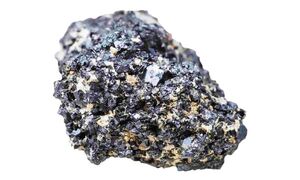
Perovskites, a ‘dirt cheap’ alternative to silicon, just got a lot more efficient
"The secret, a University of Rochester optics professor explains, is to harness the power of metals. Silicon, the standard semiconducting material used in a host of applications—computer central processing units (CPUs), semiconductor chips, detectors, and solar cells—is an abundant, naturally occurring material. However, it is expensive to mine and to purify. Perovskites—a family of materials nicknamed for their crystalline structure—have shown extraordinary promise in recent years as a far less expensive, equally efficient replacement for silicon in solar cells and detectors. Now, a study led by Chunlei Guo, a professor of optics at the University of Rochester, suggests perovskites may become far more efficient. Researchers typically synthesize perovskites in a wet lab, and then apply the material as a film on a glass substrate and explore various applications Guo instead proposes a novel, physics-based approach." [...]

High-performance computer with quantum coprocessor
"With 9 million euros in funding from the NextGenerationEU recovery plan for Europe, the University of Innsbruck will combine a quantum computer with a supercomputer in the coming months. The novel system will be used in various fields such as computer science, physics, mathematics and beyond and will be open to all scientists in Austria for research and teaching. Many areas of science depend on the computer-aided calculation of mathematical problems. Powerful supercomputers capable of performing the most complex calculations on thousands of processors in parallel are available for this purpose. However, there are problems that are difficult to crack even for supercomputers or require exorbitant amounts of computing power. In drug research, for example, it may be necessary to calculate the energy of a molecule." [...]

Using combustion to make better batteries
"An MIT team is working to harness combustion to yield valuable materials, including some that are critical in the manufacture of lithium-ion batteries. For more than a century, much of the world has run on the combustion of fossil fuels. Now, to avert the threat of climate change, the energy system is changing. Notably, solar and wind systems are replacing fossil fuel combustion for generating electricity and heat, and batteries are replacing the internal combustion engine for powering vehicles. As the energy transition progresses, researchers worldwide are tackling the many challenges that arise. Sili Deng has spent her career thinking about combustion." [...]
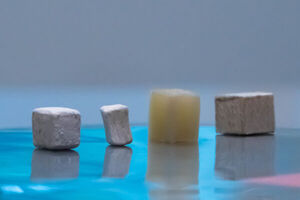
Engineered wood grows stronger while trapping carbon dioxide
"Rice U. scientists’ method could lower both emissions and building construction costs Rice University scientists have figured out a way to engineer wood to trap carbon dioxide through a potentially scalable, energy-efficient process that also makes the material stronger for use in construction. Structural materials like steel or cement come at a high cost both in dollars and carbon dioxide emissions; building construction and use accounts for an estimated 40% of emissions. Developing sustainable alternatives to existing materials could help mitigate climate change and reduce carbon dioxide emissions. Working to address both issues at once, materials scientist Muhammad Rahman and collaborators found a way to incorporate molecules of a carbon dioxide-trapping crystalline porous material into wood, according to a study published in Cell Reports Physical Science. “Wood is a sustainable, renewable structural material that we already use extensively,” Rahman said. “Our engineered wood did exhibit greater strength than normal, untreated wood.” To achieve the feat, the network of cellulose fibers that gives wood its strength is first cleared out through a process known as delignification." [...]
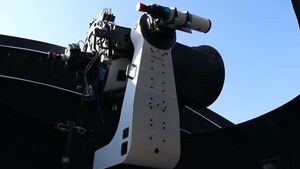
First Satellite Observatory for Quantum Optical Communication in Israel
"Tel Aviv University's observatory is among the most advanced in the world Tracking Satellites on the Move The station includes a satellite observatory dome with a diameter of 4.25 meters, a tracking system, a primary high-speed camera and secondary tracking cameras, laser equipment, single-photon detectors, and a tracking robot that can carry two telescopes simultaneously. At this stage, the robot arm holds a 24-inch telescope, and in the next stage, the observatory will be equipped with another telescope designed for photography in the infrared range, as well as thermal and hyperspectral cameras. “The ground station is designed for observing satellites, which are small bodies 400-500 kilometers high that move at about 30,000 kilometers an hour,” says Prof. Yaron Oz, head of the Center for Quantum Science and Technology at Tel Aviv University. “The ability to track satellites is a very precise skill. The satellite passes by very quickly, and during this time you must photograph it in the center of the image and in several different ranges of the electromagnetic spectrum to learn details about it. This is the first and only satellite observatory in Israel, and it is among the most advanced in the entire world.” In addition to regular optical communication, which uses lasers or LEDs of different wavelengths, the new ground station will also enable the conduction of experiments in quantum optical communication." [...]
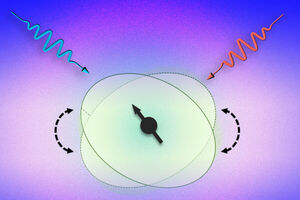
Engineers discover a new way to control atomic nuclei as “qubits”
"Using lasers, researchers can directly control a property of nuclei called spin, that can encode quantum information. In principle, quantum-based devices such as computers and sensors could vastly outperform conventional digital technologies for carrying out many complex tasks. But developing such devices in practice has been a challenging problem despite great investments by tech companies as well as academic and government labs. Today’s biggest quantum computers still only have a few hundred “qubits,” the quantum equivalents of digital bits. Now, researchers at MIT have proposed a new approach to making qubits and controlling them to read and write data. The method, which is theoretical at this stage, is based on measuring and controlling the spins of atomic nuclei, using beams of light from two lasers of slightly different colors." [...]
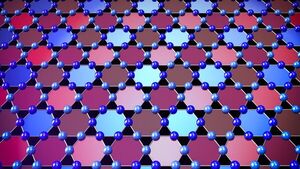
Researchers detail never-before-seen properties in a family of superconducting Kagome metals
"Scientists describe the microscopic structure of a recently discovered group of superconductors for the first time, a small step toward paving the way for future advances in superconducting technology. Dramatic advances in quantum computing, smartphones that only need to be charged once a month, trains that levitate and move at superfast speeds. Technological leaps like these could revolutionize society, but they remain largely out of reach as long as superconductivity — the flow of electricity without resistance or energy waste — isn’t fully understood. One of the major limitations for real-world applications of this technology is that the materials that make superconducting possible typically need to be at extremely cold temperatures to reach that level of electrical efficiency. To get around this limit, researchers need to build a clear picture of what different superconducting materials look like at the atomic scale as they transition through different states of matter to become superconductors. Scholars in a Brown University lab, working with an international team of scientists, have moved a small step closer to cracking this mystery for a recently discovered family of superconducting Kagome metals." [...]
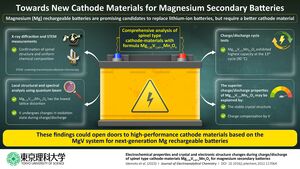
Beyond Lithium: A Promising Cathode Material for Magnesium Rechargeable Batteries
"Lithium-ion batteries have remained unrivaled in terms of overall performance for several applications, as evidenced by their widespread use in everything from portable electronics to cellular base stations. However, they suffer from few important disadvantages that are difficult to ignore. For one, lithium is rather expensive, and the fact that it is being mined at an extreme pace does not help. Moreover, the energy density of lithium-ion batteries is not enough to grant autonomy to electric vehicles and heavy machinery. These concerns, coupled with the fact that the batteries are highly unsafe when punctured or at high temperatures, have caused scientists to look for alternative technologies. Among the various elements being tested as efficient energy carriers for rechargeable batteries, magnesium (Mg) is a promising candidate." [...]
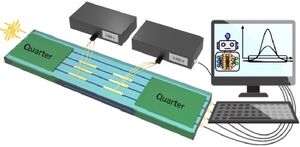
Deep learning for quantum sensing
"Artificial intelligence assists quantum metrology for greater efficiency with an innovative model-free learning algorithm Quantum sensing represents one of the most promising applications of quantum technologies, with the aim of using quantum resources to improve measurement sensitivity. In particular, sensing of optical phases is one of the most investigated problems, considered key to developing mass-produced technological devices. Optimal usage of quantum sensors requires regular characterization and calibration. In general, such calibration is an extremely complex and resource-intensive task — especially when considering systems for estimating multiple parameters, due to the sheer volume of required measurements as well as the computational time needed to analyze those measurements. Machine-learning algorithms present a powerful tool to address that complexity. The discovery of suitable protocols for algorithm usage is vital for the development of sensors for precise quantum-enhanced measurements." [...]

Mechanical engineering meets electromagnetics to enable future technology
"Reconfigurable antennas -- those that can tune properties like frequency or radiation beams in real time, from afar -- are integral to future communication network systems, like 6G. But many current reconfigurable antenna designs can fall short: they dysfunction in high or low temperatures, have power limitations or require regular servicing. To address these limitations, electrical engineers in the Penn State College of Engineering combined electromagnets with a compliant mechanism, which is the same mechanical engineering concept behind binder clips or a bow and arrow. They published their proof-of-concept reconfigurable compliant mechanism-enabled patch antenna today (Feb. 13) in Nature Communications. "Compliant mechanisms are engineering designs that incorporate elements of the materials themselves to create motion when force is applied, instead of traditional rigid body mechanisms that require hinges for motion," said corresponding author Galestan Mackertich-Sengerdy, who is both a doctoral student and a full-time researcher in the college's School of Electrical Engineering and Computer Science (EECS). "Compliant mechanism-enabled objects are engineered to bend repeatedly in a certain direction and to withstand harsh environments."" [...]
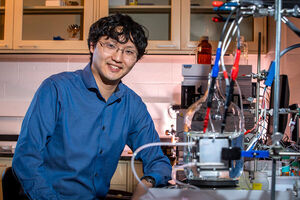
Study demonstrates energy-efficient conversion of nitrate pollutants into ammonia
"The nitrate runoff problem, a source of carcinogens and a cause of suffocating algal blooms in U.S. waterways, may not be all gloom and doom. A new study led by the University of Illinois Urbana-Champaign demonstrates an approach for the integrated capture and conversion of nitrate-contaminated waters into valuable ammonia within a single electrochemical cell. The study, directed by chemical and biomolecular engineering professor Xiao Su, demonstrates a device capable of an eightfold concentration of nitrate, a 24-times enhancement of ammonium production rate and a greater than tenfold enhancement in energy efficiency compared with previous nitrate-to-ammonia electrocatalysis methods. “By combining separation with reaction, we overcame previously existing limitations of producing ammonia directly from groundwater, where the concentrations of nitrate are very low, and thus make the conversion step inefficient,” Su said. The findings are published in the journal Nature Communications. “The goal of this study was to use as little energy as possible to remove nitrate from agricultural runoff before it hits our waterways, and transform it back to a fertilizer or sell it as a chemical feedstock,” Su said." [...]
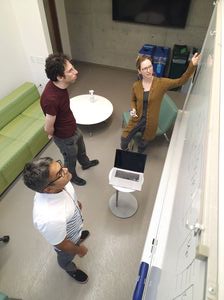
Securing supply chains with quantum computing
"The Russo-Ukrainian conflict and the COVID-19 pandemic have shown how vulnerable global supply chains can be. International events can disrupt manufacturing, delay shipping, induce panic buying and send energy costs soaring. New research in quantum computing at Sandia National Laboratories is moving science closer to being able to overcome supply-chain challenges and restore global security during future periods of unrest. "Reconfiguring the supply chain on short notice is an exceptionally difficult optimization problem, which restricts the agility of global trade," said Alicia Magann, a Truman Fellow at Sandia. She has led the development of a new way to design programs on quantum computers, which she and her team think could be especially useful for solving these kinds of massive optimization problems someday in the future when quantum technology becomes more mature. The Sandia team recently published the new approach in two joint papers in the journals Physical Review Letters and Physical Review A." [...]

Proposed quantum device may succinctly realize emergent particles such as the Fibonacci anyon
"Long before Dr. Jukka Vayrynen was an assistant professor at the Purdue Department of Physics and Astronomy, he was a post-doc investigating a theoretical model with emergent particles in a condensed matter setting. Once he arrived at Purdue, he intended to expand on the model, expecting it to be relatively easy. He gave the seemingly straightforward calculations to Guangjie Li, a graduate student working with Vayrynen, but the calculations yielded an unexpected result. These results were a surprising roadblock which nearly brought their research to a screeching halt. Team tenacity has taken this roadblock and turned it into a possible route to the development of quantum computing. At the Aspen Center for Physics in Colorado, Vayrynen discussed this issue with a colleague from the Weizmann Institute of Science in Israel, Dr. Yuval Oreg, who helped circumvent the obstacle." [...]

Two-dimensional oxides open door for high-speed electronics
"Advances in computing power over the decades have come thanks in part to our ability to make smaller and smaller transistors, a building block of electronic devices, but we are nearing the limit of the silicon materials typically used. A new technique for creating 2D oxide materials may pave the way for future high-speed electronics, according to an international team of scientists. “One way we can make our transistors, our electronic devices, work faster is to shrink the distance electrons have to travel between point A and B,” said Joshua Robinson, professor of materials science and engineering at Penn State. “You can only go so far with 3D materials like silicon — once you shrink it down to a nanometer, its properties change. So there’s been a massive push looking at new materials, one of which are 2D materials.” The team, led by Furkan Turker, graduate student in the Department of Materials Sciences, used a technique called confinement hetroepitaxy, or CHet, to create 2D oxides, materials with special properties that can serve as an atomically thin insulating layer between layers of electrically conducting materials. “Now we can create essentially the world’s thinnest oxides — just a few atoms thick,” Turker said." [...]

Scientists Can Now Map Lightning in 3D
"A new approach enables meter-scale localization of lightning strikes. And it’s already illuminating the basic physics of the phenomenon. Studying lightning is as hard as you might expect. One promising technique to study the ephemeral surges is to measure the radio waves generated by a lightning event using an array of antennas. This technique, called radio-frequency interferometry, has been around since the late 20th century. In prior work, for example, researchers integrated this method with polarized antennas to pinpoint the angular position of a strike and to detect the polarization state of the incoming radio waves." [...]
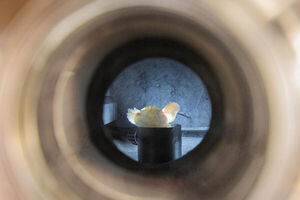
FAMU-FSU researchers find thermal limits of advanced nanomaterials
"A team of FAMU-FSU College of Engineering researchers at the High-Performance Materials Institute is exploring the thermal limits of advanced nanomaterials, work that could have a direct impact on medicine delivery systems, electronics, space travel and other applications. The research team, led by Assistant Professor in Industrial and Manufacturing Engineering Rebekah Sweat, completed the first-ever study on how purified boron nitride nanotubes remain stable in extreme temperatures in inert environments. Their work was published in the journal Applied Nano Materials. Boron nitride nanotubes, or BNNTs, are stronger and more resistant to high temperatures than carbon nanotubes. Like their carbon cousins, they are structures measured by the nanometer — a length equal to one-billionth of a meter. But manufacturing these materials is challenging." [...]
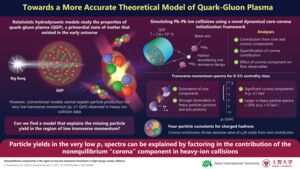
New Model of Quark-Gluon Plasma Solves a Long-Standing Discrepancy between Theory and Data
"Researchers from Japan provide a novel theoretical framework for describing the quark-gluon plasma, which agrees better with experimental data The properties of quark-gluon plasma (QGP), the primordial form of matter in the early universe, is conventionally described using relativistic hydrodynamical models. However, these models predict low particle yields in the low transverse momentum region, which is at odds with experimental data. To address this discrepancy, researchers from Japan now propose a novel framework based on a “core-corona” picture of QGP, which predicts that the corona component may contribute to the observed high particle yields. Research in fundamental science has revealed the existence of quark-gluon plasma (QGP) – a newly identified state of matter – as the constituent of the early universe. Known to have existed a microsecond after the Big Bang, the QGP, essentially a soup of quarks and gluons, cooled down with time to form hadrons like protons and neutrons – the building blocks of all matter. One way to reproduce the extreme conditions prevailing when QGP existed is through relativistic heavy-ion collisions." [...]
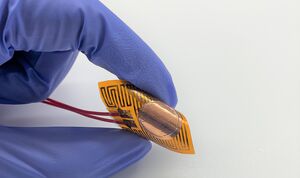
How a sandwich is transforming electronics
"Sheng Shen’s novel 3D graphene-nanowire “sandwich” can enable a wide variety of electronic systems to operate at a lower temperature with higher performance. As devices get smaller and more powerful, the risk of them overheating and burning out increases substantially. Despite advancements in cooling solutions, the interface between an electronic chip and its cooling system has remained a barrier for thermal transport due to the materials’ intrinsic roughness. Sheng Shen, a professor of mechanical engineeringOpens in new window, has fabricated a flexible, powerful, and highly-reliable material to efficiently fill the gap. “At first glance, our solution looks like any ordinary copper film, but under a microscope the novelty of our material becomes clear,” explained Lin Jing, Ph.D. student. The material, composed of two thin copper films with a graphene-coated copper nanowire array sandwiched between them, is extremely user-friendly." [...]
Projetos Maker
Diversos Projetos interessantes.
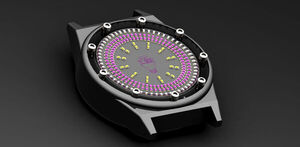
The603-200
"The 603-200 is the first watch of a planed line of watches based on the same concept which is inspired by the Japanese TokyoFlash® brand (www.tokyoflash.com). We want to push the concept to a fully modern connected watch capable of establishing communication with your SmartPhone or any other IoT. This watch is an open source device. The customers and makers have access to all the documentation • Kicad-Pcb® files to make correction or updates • Arduino IDE Sketches available from www.github.com to update or modify the watch’s behaviour • Python code available from www.github.com to update or modify the watch’s behaviour. You get access to hundreds of ESP32 code coming from the makers community. • Technical documentation to create new top side displays (sister boatrd) and design add-ons • 3D files for CNC and 3D printers for those willing to create enclosure/shells in various material What the watch can do : The 603-200 Morphwatch® has been mainly design to produce exciting visual effects with its collertion of 192 leds." [...]
Silicon reverse-engineering: the Intel 8086 processor's flag circuitry
"Status flags are a key part of most processors, indicating if an arithmetic result is negative, zero, or has a carry, for instance. In this post, I take a close look at the flag circuitry in the Intel 8086 processor (1978), the chip that launched the PC revolution.1 Looking at the silicon die of the 8086 reveals how its flags are implemented. The 8086's flag circuitry is surprisingly complicated, full of corner cases and special handling. Moreover, I found an undocumented zero register that is used by the microcode. The die photo below shows the 8086 microprocessor under a microscope. The metal layer on top of the chip is visible, with the silicon and polysilicon mostly hidden underneath." [...]

Build your own Raspberry Pi weather station with weather forecast and ESP32 wireless sensors
"For years now, one of these typical weather stations has been sitting in my living room. It works as it should, but it lacks a second or even third radio sensor, and a weather forecast would be a great addition. That's why I started building my own weather station a few weeks ago, one that could cover all my wishes if possible. In the meantime, the weather station is running stable, so I would like to give you a description of how my project is built. All components are available on GitHub and linked at the corresponding sections. What should the weather station be capable of?" [...]
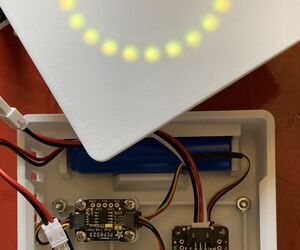
DIY Carbon Dioxide (CO2) Detector
"A couple of weeks ago, I read an article about CO2 levels and how they may indicate higher transmission of COVID-19 in an indoor space. After reading this article, I wanted to take a crack at designing a simple CO2 detector that could visually display carbon dioxide levels in the air. The assembly consists of a neopixel ring to display different colors to indicate the CO2 levels. I will use an SCD-41 CO2 sensor to detect the CO2 levels. I have also included a couple of other sensors to display temperature, pressure, and humidity in later iterations. An RP2040 board is set up to read these sensors and control the neopixel ring." [...]

Eurorack 4-channel mixer with VU meter
"A basic 4 channel mono audio mixer with gain amplifier and a 10 LED VU-meter BACKGROUND I am designing and building a series of Eurorack modules for interfacing modular analog synthesizers. As I am not a musician, I am more interested in learning than in actual sound quality. Which does not mean that the designs are of poor audio quality, but you might find 12-bit analog processing and, definitively, you will not find tube valve amplifiers. You may check my other Eurorack module projects. As these projects are really quite basic, I believe they might be a good starting point in the electronic music and audio electronics. I have found a good reference for designing some circuits for the projects in the following books: Ray Wilson (2013) "Make: Analog Synthesizers: Make Electronic Sounds the Synth-DIY Way", Make Media, Sebastopol CA Nicolas Collins (2020) "Handmade Electronic Music: The Art of Hardware Hacking", 3rd Edition, Routledge, New York ELECTRONICS The goal of this module is merging the output from other Eurorack modules." [...]

Arduino Based Concrete Clock With Touchless Night Lamp
"In this tutorial, I am going to show you guys how to create this Arduino based touchless concrete clock. When you mix creativity with electronics, it becomes a masterpiece. Producing something original and worthwhile leads to the creation of a number of great new useful household products. In this video, I am going to show you guys how to create this Arduino based touchless concrete clock. I always love to generate a 3D model of my product before creating it in real. This not only gives me a better view of what the final product is going to look like, but also helps me in finding the correct measurements of the final product." [...]
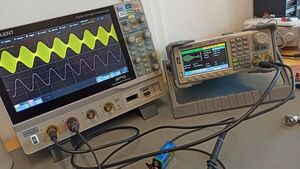
JFET-based infinite impedance detector for AM-demodulation
"The so-called “infinite impedance detector” is a circuit that was commonly used in the old days of vacuum tubes. Since vacuum tubes can be somewhat considered to be heated JFETs, it is evident that such a circuit can also be built using a more modern, silicon-based approach. This article covers my first experiments with a BF256B based infinite impedance detector. General Overview Infinite impedance detectors got their name from their extremely high input impedance. Of course, the real input impedance is anything but infinite. But it is relatively large." [...]

Candy Box Gameboy
"The ATTBOY is a very basic Attiny85-based game console that is housed in a candy box and runs the space invaders game. So here's something extremely cool and intriguing: a tiny Gameboy that fits inside a Candy Tin box and runs doom, no, not really. This project is essentially an Altoid game console, however, it comes in a box made by a different candy company and has a different shape than a typical Altoid tin. Altoid game consoles, also known as "Altoid tin game consoles, " are a unique type of custom game console that has become popular among DIY enthusiasts and gamers. The concept is simple: take an Altoid tin, a small, pocket-sized mint container, and transform it into a functioning handheld game console. The tin is retrofitted with components such as a microcontroller, buttons, and a screen to create a compact and portable gaming device." [...]

Multipurpose USB UART Module
"A multipurpose USB-to-UART module with built-in UPDI programming mode and Auto Flash/reset for ESP devices USB-to-Serial converters are some of the most used modules on my bench. I have quite a few of them, most of them are the cheap online type that can be had for a few dollars. As part of my new project, where I am seriously looking for an alternative chip to replace the ATMEGA328, which has become almost impossible to get, and super expensive when you do get it, I needed to get hold of a UPDI programmer. There are many available online, from cheap to more expensive, but I wanted to build my own, as it did not seem too difficult to do. As another part of my daily tasks, I also use a lot of ESP-type chips, which have a particular procedure to upload code via an external serial adapter. The idea was thus to design a USB UART module that has multiple purposes, as well as being easy and cheap to assemble." [...]

Lazy Mini Grid
"A late happy new year, everyone! Here's another LED grid. The ones I built so far always used LED strips with either 60 or 30 LEDs/meter. And so does this one, it's using 60 LEDs/meter, 90 in total (or 1.5m) - resulting in a 5x17 grid and 5 unused LEDs to avoid soldering. (Actually I designed one using 144 LEDs/m before this one, but that's a different story and I might add pictures and a few words at the end of this Instructable why that one didn't work out so well) The difference to my previous grids is the "offset" introduced to effectively double the density of the grid. The previous one was using 16.675mm cell size (distance LED center to LED center), this one is using 8.34mm." [...]
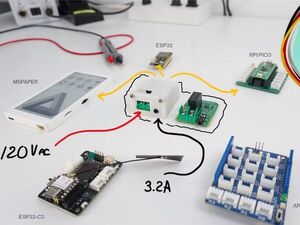
Energy Monitoring Module for any Dev Board
"Measure voltage, current, active power, power factor, and electrical energy with any microcontroller through UART. The problem If we knew how much energy we use at each moment, I am convinced that we would use it better, just for the pleasure of seeing the consumption metrics go down. I verified this once I installed a screen showing the energy consumption of my house in the corridor. With the fact of announcing that the number with the W next to it, the bigger it was, the more expensive the bill would be at the end of the month, I already had my family turning off things, just to see it go down. I've been making videos of power meters for a while now and I set out to create a metering module that we could easily use with any microcontroller. If you are a visual learner I know that a video is worth more than 1000 words, so here is a tutorial video." [...]

How to visualize how WS2812 LEDs work
"Can WS2812-strips change their colors with the speed of light? No, not really. But can you watch the transmission of data? Yes, you can! Fans of WS2812 strips are happy as soon as their application works as intended. But do they ever check how things work internally?" [...]
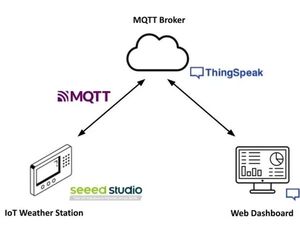
IoT weather station with Seeed Studio
"Monitoring the environmental data using Seeed Studio XIAO ESP32C3, Arduino, and MQTT. In this article, I will describe the creation of an IoT weather station using Seeed Studio devices, which is able to measure and display temperature and humidity levels. The station features an OLED screen that displays the current readings, as well as the ability to remotely access the data through a web platform using an MQTT server connection. This allows you to monitor the weather conditions in your area from anywhere with internet access. This project is an excellent opportunity to learn more about IoT and weather monitoring, and how to use Seeed Studio products to build your IoT projects. " [...]

CryptMaster 2001
"This is another quick and quirky project I put together for my two younger kids: a pair of simple, handheld devices that let them enter text and then write down the its encrypted representation on a piece of paper. The recipient of this coded message can then enter it on their device to recover the original text. The interface is simple: turning the decorative knob on the right lets you cycle through the alphabet. A short press of the small tactile button on the left advances the cursor to the next position. A longer press erases all previously entered text. The circuit is similarly uncomplicated." [...]

Using WiFi to Monitor Sensor Data
"This tutorial will show you how setup a simple peer-to-peer connection to send and receive sensor data between two ESP32 WiFi boards. Introduction We’re all familiar with WiFi. It runs our home, let’s us stream our favorite movies, and keeps us from having to talk with other people when we’re at a coffee shop. But there's more ways to use WiFi than simply accessing the internet through different applications. In this tutorial, we'll show you how to set up your own peer-to-peer network to sense data from one area and send that data to an LCD screen somewhere else without needing any internet connection or routers. This a great first step in being able to remove the wires from any embedded physical computing application." [...]
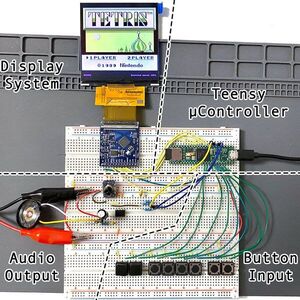
Breadboard Gameboy
"A Gameboy emulator assembled on a breadboard that runs 1989's Tetris at full speed with sound! Ever wanted to play the original Gameboy's Tetris on a breadboard? Well, now you can. This fully functional Gameboy emulation assembled on a breadboard is running on top of the popular Teensy 4 development board and features a beautiful, large display and full 4-channel audio support. The project uses a Teensy 4.1 as its main processing unit and storage device (SD card). The FT81x Arduino Driver is used as a display system." [...]
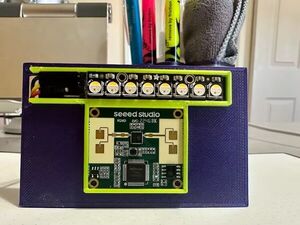
Working with MR24HPC1
"Get started with seeed static human presence sensor Well, this project is a by product. I wanted to recreate one of my projects buddy by replacing AK9753 - Human Presence Sensor with low cost 24GHz mmWave Sensor - Human Static Presence. When I was receive the sensor from Seeed, I wanted to quickly test it's accuracy to evaluate if it will fit my use case. Unfortunately, I was not satisfied with the reading out of the box. Then I got in touch with Seeed engineers who recommended to make some adjustment to the sensor based on my room. With those changes, I got pretty good readings." [...]
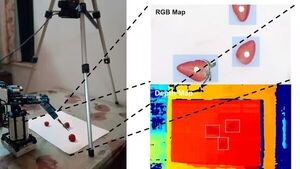
Gelāre: Depth-sensing & EdgeImpulse powered Assistive-Robots
"Towards Spatial-guided Vision based Assistive Robotics using EdgeImpulse and LEGO Mindstorms. Problem Statement The ability to feed oneself is a crucial aspect of daily living, and losing this ability can have a significant impact on a person's life. Robotics has the potential to assist with this task. The development of a successful robotic assistive feeding system depends on its ability to acquire bites of food accurately, time the bites appropriately, and transfer the bites easily in both individual and group dining settings. However, the task of automating bite acquisition is challenging due to the vast variety of foods, utensils, and human strategies involved, as well as the need for robust manipulation of a deformable and hard-to-model target. Bite timing, especially in social dining settings, requires a delicate balance of multiple forms of communication, such as gaze, facial expressions, gestures, and speech, as well as action and sometimes coercion." [...]
Secção Videos
Videos interessantes.
That's all Folks!





